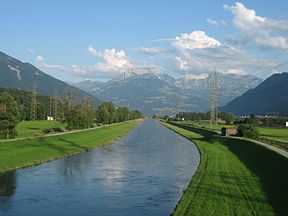Linth
| Linth | |
|---|---|
 The Linth near Reichenburg | |
| Origin | Canton of Glarus, Switzerland |
| Mouth | Lake Zurich |
| Basin countries | Switzerland |
| Length | 50 kilometres (31 mi) |
The Linth (pronounced [ˈlɪnt] "lint") is a Swiss river starting near the Klausen Pass above Linthal in the mountains of Glarus. It initially flows north through the canton of Glarus, passing Schwanden, where it is joined by its main tributary the Sernf, Ennenda, the town of Glarus, Netstal, and Näfels, from where it is channeled into Lake Walen (Walensee). It leaves Lake Walen at Weesen and flows west from there as Linth Channel through the Linth Plain and near Schmerikon into the Lake Zurich of which it is the main tributary. It is totally about 50 km long. The highest point of the drainage basin is the summit of Tödi, at 3,614 metres.
The water power of the Linth was a main factor in the creation of the textile industry of the canton Glarus.
The Linth river control
The taming of the Linth (Linthkorrektur) from 1807 to 1823 was one of the great engineering feats of the early 19th century, the earliest project of such a size undertaken by the new Swiss state, and a great example of solidary action in early Switzerland.

In the second half of the 18th century, the situation of the population in the lower Glarus valley, the Linth Plain and around Lake Walen, was pretty disastrous: Cutting down the woods of the Glarus valley during early industrialization led to more and more gravel coming down with the yearly spring high water which was deposited at the joining of Linth and Maag, the outflow of the Lake Walen, in the plain between Lake Walen and Lake Zurich. This caused frequent floodings and a backwater of Linth and Maag which made the level of Lake Walen rise several meters and turned the whole countryside into swamps. Agriculture was more and more difficult, the poverty increased, and diseases like Tuberculosis and Malaria were rampant.

The statesman, scientist, painter and manager Conrad Escher (later named "von der Linth") from Zurich developed and executed the plan of channeling the Linth into Lake Walen, where the gravel could be deposited without damage. A second channel, the Linth Channel connected the lakes of Walen and Zurich, replacing the former Maag. The picture shows Conrad Escher's plan of the correction from the archive of ETH Zurich:
The river correction put an end to the floodings, lowered the level of Lake Walen by five meters which greatly improved living conditions for the population, and dried up the swamps, resulting in 20 km² arable land in the Linth plain.
External links and references
| Wikimedia Commons has media related to Linth. |
-
 Chisholm, Hugh, ed. (1911). "Linth". Encyclopædia Britannica (11th ed.). Cambridge University Press
Chisholm, Hugh, ed. (1911). "Linth". Encyclopædia Britannica (11th ed.). Cambridge University Press - Doctoral Thesis of Daniel Speich, ETH Zurich (German)
- Daniel Speich: The Linth Valley Hydro Engineering Scheme (1807-1823) and the Genesis of Swiss National Unity, Environment and History 8(2002) 429-447
- the Linth valley on Google Maps
| |||||||||||||||||||||||||||||
Coordinates: 46°58′59″N 9°00′34″E / 46.9830°N 9.0095°E
